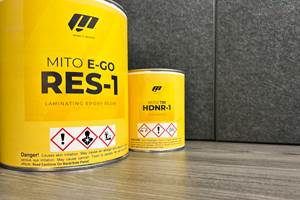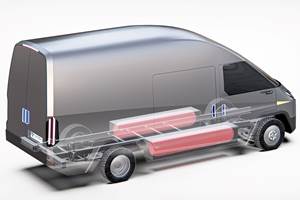NASA considers carbon nanotube mirrors for cubesat telescope
The carbon nanotube/epoxy combination is being evaluated for the fabrication of mirrors on cubesats for planetary space exploration and Earth observations.
NASA reports that a lightweight telescope that a team of its scientists and engineers is developing for cubesat scientific investigations could become the first to carry a mirror made of carbon nanotubes in an epoxy resin.
Led by Theodor Kostiuk, a scientist at NASA’s Goddard Space Flight Center in Greenbelt, Maryland, the technology development effort is aimed at giving the scientific community a compact, reproducible, and relatively inexpensive telescope that would fit easily inside a cubesat. Individual cubesats measure four inches on a side.
Cubesats provide a low-cost platform for NASA missions, including planetary space exploration, Earth observations, fundamental Earth and space science and developing precursor science instruments like laser communications, satellite-to-satellite communications and autonomous movement capabilities. They also allow an inexpensive means to engage students in all phases of satellite development, operation and exploitation through real-world, hands-on research and development experience on NASA-funded rideshare launch opportunities.
In addition to being lightweight, highly stable, and easily reproducible, carbon-nanotube mirrors do not require polishing — a time-consuming and expensive process typically required to assure a smooth, perfectly shaped mirror, says Kolasinski, an engineer and science collaborator on the project.
To make a mirror, technicians simply pour the mixture of epoxy and carbon nanotubes into a mandrel or mold fashioned to meet a particular optical prescription. They then heat the mold to to cure and harden the epoxy. Once set, the mirror then is coated with a reflective material of aluminum and silicon dioxide.
“After making a specific mandrel or mold, many tens of identical low-mass, highly uniform replicas can be produced at low cost,” Chen said. “Complete telescope assemblies can be made this way, which is the team’s main interest. For the CubeSat program, this capability will enable many spacecraft to be equipped with identical optics and different detectors for a variety of experiments. They also can be flown in swarms and constellations.”
Under this R&D effort, Kostiuk’s team seeks to develop a cubesat telescope that would be sensitive to ultraviolet, visible and infrared wavelength bands. It would be equipped with commercial, off-the-shelf spectrometers and imagers and would be ideal as an “exploratory tool for quick looks that could lead to larger missions,” Kostiuk says. “We’re trying to exploit commercially available components.”
With funding from Goddard’s Internal Research and Development program, the team has created a laboratory optical bench made up of three commercially available, miniaturized spectrometers optimized for the ultraviolet, visible and near-infrared wavelength bands. The spectrometers are connected via fiber optic cables to the focused beam of a 3-inch diameter carbon nanotube mirror. The team is using the optical bench to test the telescope’s overall design.
“No one has been able to make a mirror using a carbon nanotube resin,” says Peter Chen, a Goddard contractor and president of Lightweight Telescopes Inc., a Columbia, Maryland-based company working with the team to create the cubesat-compatible telescope.
“This is a unique technology currently available only at Goddard,” he says. “The technology is too new to fly in space, and first must go through the various levels of technological advancement. But this is what my Goddard colleagues (Kostiuk, Tilak Hewagama, and John Kolasinski) are trying to accomplish through the cubesat program.”
Chen also believes this material also would work for larger telescopes, particularly those comprised of multiple mirror segments. Eighteen hexagonal-shape mirrors, for example, form the James Webb Space Telescope’s 21-ft primary mirror and each of the twin telescopes at the Keck Observatory in Mauna Kea, Hawaii, contain 36 segments to form a 32-ft mirror.
Many of the mirror segments in these telescopes are identical and can therefore be produced using a single mandrel. This approach avoids the need to grind and polish many individual segments to the same shape and focal length, thus potentially leading to significant savings in schedule and cost. Moreover, carbon-nanotube mirrors can be made into ‘smart optics’. To maintain a single perfect focus in the Keck telescopes, for example, each mirror segment has several externally mounted actuators that deform the mirrors into the specific shapes required at different telescope orientations.
In the case of carbon-nanotube mirrors, the actuators can be formed into the optics at the time of fabrication. This is accomplished by applying electric fields to the resin mixture before cure, which leads to the formation of carbon-nanotube chains and networks. After cure, technicians then apply power to the mirror, thereby changing the shape of the optical surface. This concept has already been proven in the laboratory.
For more technology news, go to gsfctechnology.gsfc.nasa.gov/newsletter/Current.pdf
Related Content
JEC World 2023 exhibit preview: Mito Materials Solutions
At the Startup Hub, Mito is availabile to discuss its ready-to-pour graphene resin options, customer applications and solutions for taking graphene from the lab to the real world.
Read MoreJEC World 2023 highlights: Recyclable resins, renewable energy solutions, award-winning automotive
CW technical editor Hannah Mason recaps some of the technology on display at JEC World, including natural, bio-based or recyclable materials solutions, innovative automotive and renewable energy components and more.
Read MoreViritech and Haydale pursue new functionalized materials for Type V composite vessels for hydrogen storage
Goal is considerable weight savings via lightweight, impermeable pressure vessels without a liner, further advance in Graph-Pro structural storage tanks with integrated fixation.
Read MoreGoodman Technologies, partners scale up AI-empowered 3D printing of nanocomposites for spacecraft TPS
NASA project addresses the capability gap in TPS production and installation for space exploration and hypersonic systems, delivering an ARMs system, nanopaste and prepreg tapes, manufacturing verification coupons and more.
Read MoreRead Next
“Structured air” TPS safeguards composite structures
Powered by an 85% air/15% pure polyimide aerogel, Blueshift’s novel material system protects structures during transient thermal events from -200°C to beyond 2400°C for rockets, battery boxes and more.
Read MorePlant tour: Daher Shap’in TechCenter and composites production plant, Saint-Aignan-de-Grandlieu, France
Co-located R&D and production advance OOA thermosets, thermoplastics, welding, recycling and digital technologies for faster processing and certification of lighter, more sustainable composites.
Read MoreVIDEO: High-volume processing for fiberglass components
Cannon Ergos, a company specializing in high-ton presses and equipment for composites fabrication and plastics processing, displayed automotive and industrial components at CAMX 2024.
Read More

























